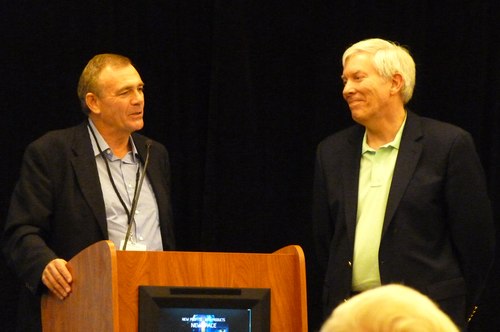
Neil Milburn (left) of Armadillo Aerospace speaks at the NewSpace 2012 Conference on Thursday after receiving a launch license from George Nield (right), associate administrator for commercial space transportation at the FAA. (credit: J. Foust)
Armadillo Aerospace is one step closer to flying a rocket into space after receiving a launch license from the FAA on Thursday. During a brief presentation at the NewSpace 2012 Conference in Santa Clara, California, FAA associate administrator for commercial space transportation George Nield awarded Armadillo a suborbital reusable launch vehicle license for its STIG-B rocket. Nield noted that this is only the third such licensed awarded by the FAA, after ones given to Scaled Composites and XCOR Aerospace, and is the only currently-active suborbital RLV launch license.
Neil Milburn, Armadillo’s vice president of program management, praised the FAA Office of Commercial Space Transportation (AST) for the speed in which it awarded the license. “AST is allowed by law 180 days to review your license [application] and say yea or nay,” he said. “This time around they did it in 63 days, which I’m pretty sure is a record.”
Armadillo is planning the first launch of the STIG-B the weekend of August 25-26 at Spaceport America in New Mexico, with of goal of reaching an altitude of 100 kilometers. While previous launches of Armadillo’s STIG rockets were done under waivers, the performance of the rocket, as well as the fact that the launch is generating revenues from payloads onboard (it’s carrying experiments for Europe’s Vega Space and the University of Purdue) required a full-fledged launch license. The launch would also qualify Armadillo to carry payloads for NASA’s Flight Opportunities program.
The rocket itself is still coming together at Armadillo’s Texas facility. “It should be together as a complete vehicle in the next ten days,” he said. There’s also a series of verification tests, integration of the experiment payloads, and hot-fire tests of the engine planned before the launch. Last weekend, he said, they were in Arizona doing drop tests of the vehicle’s recovery system, which includes a steerable parafoil to bring the vehicle back to the launch site. “There’s a lot of work to do in the next three, four weeks.”
Milburn said they eventually plan to fly STIG-B on a monthly basis, building up experience that they will fold into their later plans for a suborbital crewed vehicle, Hyperion. “One of the things we wanted to do with the STIG family of vehicles is to use it as a flying testbed for all of the technologies we need to fly the Hyperion-class vehicle,” a two-person suborbital vehicle. “Our philosophy has always been to learn your lessons at the lowest possible cost with the smallest possible vehicle as quickly as you can. And fly often, because that’s when you find out where all the weak areas are.”

Leave a Reply